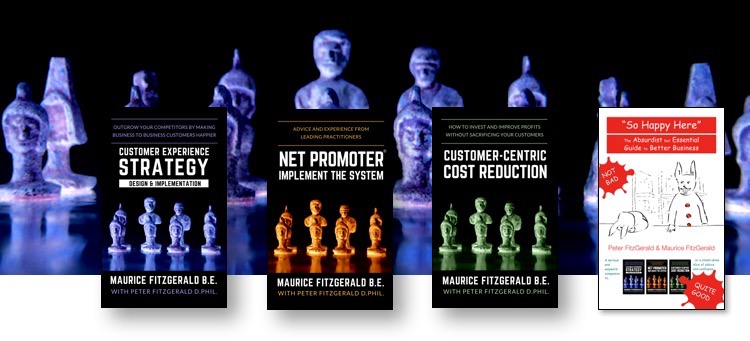#81 – Goodhart’s Law, eCommerce again, loyalty equals cost reduction, VOC program design
 Goodhart’s Law and being careful about metrics, eCommerce that competes with own retail stores. Welcome to the 81st edition of my customer strategy newsletter. The five topics this week are:
Goodhart’s law is 43 years old – We still need to be careful with metricsCharles Goodhart is a British economist. He remains disappointed that he is best known for something he wrote way back in 1975. His original words were not terribly inspiring: Any observed statistical regularity will tend to collapse once pressure is placed upon it for control purposes. He was writing about UK monetary policy and the point he was making was that if a particular metric, such as the M2 Money Supply, became the sole focus of monetary supply it would be made to look better, no matter what the underlying reality. Let me try to rephrase the ‘law’. Once a single metric becomes a major focus the people being measured will make sure it improves. A good example is what happened when a new emphasis was put on crime statistics in Chicago:
In the UK someone in the National Health Service decided to measure hospitals on emergency room arrivals being served in under four hours. A bizarre result was that patients were kept inside ambulances until staff were certain that they would be treated within four hours of being taken from the ambulance to inside the hospital, when the clock started to tick. Guess what? The metric improved. The same thing will happen if you measure individuals on NPS or CSAT scores. The numbers will improve, even though the reality may be unaffected. I recently came in contact with a situation where call center agents who had to phone customers who gave low scores were measured on those same scores. A surprisingly high (though not surprising to me) number of customers supposedly claimed they had not understood the survey and asked to have their scores changed from the worst to the best number. Success??? The message here is that you should not measure individuals on NPS, CSAT or indeed any score that they can personally manipulate. Customer satisfaction metrics are best used as collectives scores for a team or an entire organization. Web stores that compete with physical locations – My latest experienceIt is Black Friday as I write this. I have just had the opposite experience to the one I wrote about last week. The latest experience is not a good one. I have a loyalty card with the Fnac chain. For those unfamiliar with the brand, they sell books, CDs, DVD/Blu-Ray, photo equipment and electronics. For US readers, I would describe them as a combination of Barnes & Noble and Best Buy. Their weekly email update included a Black Friday deal with 18% off the 2018 9.7″ iPad. Since I have been looking for just that, I decided to pop into the Geneva retail store this morning. Surprise, they were marked ‘10% off’. So I went to a sales person. His answer, “Oh we never know what those web people are going to do. It’s 10% off here.” Then I pointed out that the web site says I can order at 18% off and pick it up an hour later in this very store. Answer, “If they say so, I suppose you can do it, but I can’t give you 18% off directly.” This is the exact counter-example to the one I gave last week. Your eCommerce operation cannot compete with your retail outlets. It makes customers like me think you are stupid and trying to trick us in some way. It is a well-known direct marketing phenomenon that you should not give people choices. Having different prices in-store and on the web is idiotic. It means neither price can be trusted to be the lower without checking. Our latest blog postsThe top two on this are part of a new series on a specific aspect of strategy creation: the process of asking new questions so you can get new answers. Older posts are still available on the blog page.
Notable customer experience items from other sitesFred Reichheld: The best way to cut costs is to make customers happierYou may know Fred Reichheld as the co-inventor of the Net Promoter System and the Net Promoter Score. While he is not hugely active these days, he has just written a new article that introduces an interesting twist to his favorite theme of customer loyalty. Rather than talking about revenue growth he talks about loyal customers as a cost reduction opportunity. I particularly like his point on the potential for changing sales incentives to favor rewards for customers to stay with companies for at least 18 months. Lots of good ideas in this three-minute read here. Agi Marx: Voice of the customer: Why you need it and how to start your VOC programAgi wrote this detailed blog for Thematic, where she is director of marketing. I find her insights about AI, text analytics and the importance of actionable insights quite compelling. A combination of art and science is needed to avoid simply identifying problems but not what you can do to resolve them. I think this blog provides good reading for any company that is setting up a Voice of the Customer program or trying to improve what they already have. It is about a ten-minute read and you can find it here. Looking forwardThank you for the great feedback on the ‘ask new questions’ blog posts on customers and partners. The next one will be on competitors. Here are links to all of our books on Amazon.com. Kindle versions are available in all stores. Print versions are available from the major stores only. If you have already read any of our books, please write reviews on Amazon. Customer Experience Strategy – Design & Implementation Net Promoter – Implement the System Customer-centric Cost Reduction “So Happy Here”: The Absurdist but Essential Guide to Better Business (Color edition) “So Happy Here”: The Absurdist but Essential Guide to Better Business (Black & White edition) Please share this newsletter with your friends and colleagues and encourage them to sign up for it here. I have put links to past newsletters on the subscription page. Finally, please feel free to change or cancel your subscription using the link below. You can also email me, Maurice FitzGerald, at mfg@customerstrategy.net. |






